Spatial Tools for Inclusive Landscape Governance: Negotiating Land Use, Land-Cover Change, and Future Landscape Scenarios in Two Multistakeholder Platforms in Zambia
Abstract
1. Introduction
2. Conceptual Framework: Spatial Tools as Boundary Objects for Inclusive Landscape Governance
3. Materials and Methods
3.1. Study Area and Context
3.2. Selection of Participants
3.3. Data Collection and Materials
3.3.1. Satellite Data Preparation and Analysis
Dataset
Land-Cover Classes and Reference Data
Image Classification
Accuracy Assessment and Change Detection
3.3.2. Participatory Mapping Protocol
3.3.3. Data Analysis
4. Results
4.1. Land-Cover Dynamics in Chief Chikanta’s Area
4.1.1. Accuracy Assessments
4.1.2. Land Cover in Chief Chikanta’s Area in 1984 and 2020
4.1.3. Land-Cover Change in Chief Chikanta’s Area
4.2. Drivers of Landscape Change: Participants’ Views
4.3. Deliberating Landscape Dynamics to Uncover Shared Challenges
4.3.1. MSP1: Habulile Village
4.3.2. MSP2: Siankwembo Village
4.4. Participatory Mapping of Envisioned Landscapes in Focus Groups
Negotiated Mapping of Desired Future Landscapes
5. Discussion
6. Conclusions
Author Contributions
Funding
Data Availability Statement
Acknowledgments
Conflicts of Interest
Appendix A
| Year | Filter Dates | Image | Satellite | Band Combination |
|---|---|---|---|---|
| 1984 | 1 September 1984–30 September 2020 | LT05/CO1/T1_8 DAY_NDVI | Landsat | 432 |
| 2020 | 1 September 2020–30 September 2020 | LC08/C01/T1_8 DAY_TOA | Landsat | 543 |
| 1 | COLANDS (https://www.cifor-icraf.org/colands/, accessed on 16 October 2022) stands for Collaborating to Operationalise Landscape Approaches for Nature, Development and Sustainability and is an initiative led by the Centre for International Forestry Research (CIFOR) in cooperation with the University of British Columbia and the University of Amsterdam and local partners in Ghana, Zambia, and Indonesia (Reed et al. 2020). |
| 2 | Village 2 is part of the COLANDS initiative, of which this study is a part but was not included in this paper as it had no multistakeholder platform. |
References
- Bartolini, N.; DeSilvey, C. Landscape futures: Decision-making in uncertain times, a literature review. Landsc. Res. 2021, 46, 8–24. [Google Scholar] [CrossRef]
- Reed, J.; Deakin, L.; Sunderland, T. What are “Integrated Landscape Approaches” and how effectively have they been implemented in the tropics: A systematic map protocol. Environ. Evid. 2015, 4, 2. [Google Scholar] [CrossRef]
- Pelletier, J.; Paquette, A.; Mbindo, K.; Zimba, N.; Siampale, A.; Chendauka, B.; Siangulube, F.; Roberts, J.W. Carbon sink despite large deforestation in African tropical dry forests (miombo woodlands). Environ. Res. Lett. 2018, 13, 094017. [Google Scholar] [CrossRef]
- Kusiima, S.K.; Egeru, A.; Namaalwa, J.; Byakagaba, P.; Mfitumukiza, D.; Mukwaya, P.; Mensah, S.; Asiimwe, R. Interconnectedness of ecosystem services potential with Land-Use/Land-Cover change dynamics in Western Uganda. Land 2022, 11, 2056. [Google Scholar] [CrossRef]
- Do, T.H.; Vu, T.P.; Catacutan, D.; Nguyen, V.T. Governing landscapes for ecosystem services: A participatory land-use scenario development in the Northwest Montane Region of Vietnam. Environ. Manag. 2021, 68, 665–682. [Google Scholar] [CrossRef]
- Lubida, A.; Veysipanah, M.; Pilesjo, P.; Mansourian, A. Land-use planning for sustainable urban development in Africa: A spatial and multi-objective optimization approach. Geod. Cartogr. 2019, 45, 1–15. [Google Scholar] [CrossRef]
- Solly, A. Land use challenges, sustainability and the spatial planning balancing act: Insights from Sweden and Switzerland. Eur. Plan. Stud. 2021, 29, 637–653. [Google Scholar] [CrossRef]
- McCall, M.K. Seeking good governance in participatory-GIS: A review of processes and governance dimensions in applying GIS to participatory spatial planning. Habitat Int. 2003, 27, 549–573. [Google Scholar] [CrossRef]
- Mccall, M.K.; Dunn, C.E. Geo-information tools for participatory spatial planning: Fulfilling the criteria for “good” governance? Geoforum 2012, 43, 81–94. [Google Scholar] [CrossRef]
- Asubonteng, K.O.; Ros-Tonen, M.A.F.; Baud, I.; Pfeffer, K. Envisioning the future of mosaic landscapes: Actor perceptions in a mixed cocoa/oil-palm area in Ghana. Environ. Manag. 2020, 68, 701–719. [Google Scholar] [CrossRef]
- Ros-Tonen, M.A.F.; Willemen, L. Editorial: Spatial tools for integrated and inclusive landscape governance. Environ. Manag. 2021, 68, 605–610. [Google Scholar] [CrossRef] [PubMed]
- Aggrey, J.J.; Ros-Tonen, M.A.F.; Asubonteng, K.O. Using participatory spatial tools to unravel community perceptions of land-use dynamics in a mine-expanding landscape in Ghana. Environ. Manag. 2021, 68, 720–737. [Google Scholar] [CrossRef] [PubMed]
- Baggio, J.A.; Brown, K.; Hellebrandt, D. Boundary object or bridging concept? A citation network analysis of resilience. Ecol. Soc. 2015, 20, 2. [Google Scholar] [CrossRef]
- Sayer, J.; Sunderland, T.; Ghazoul, J.; Pfund, J.-L.; Sheil, D.; Meijaard, E.; Venter, M.; Boedhihartono, A.K.; Day, M.; Garcia, C.; et al. Ten principles for a landscape approach to reconciling agriculture, conservation, and other competing land uses. Proc. Natl. Acad. Sci. USA 2013, 110, 8349–8356. [Google Scholar] [CrossRef]
- Milder, J.C.; Hart, A.K.; Dobie, P.; Minai, J.; Zaleski, C. Integrated landscape initiatives for African agriculture, development, and conservation: A Region-wide assessment. World Dev. 2014, 54, 68–80. [Google Scholar] [CrossRef]
- Beunen, R.; Opdam, P. When landscape planning becomes landscape governance, what happens to the science? Landsc. Urban Plan. 2011, 100, 324–326. [Google Scholar] [CrossRef]
- Görg, C. Landscape governance. The “politics of scale” and the “natural” conditions of places. Geoforum 2007, 38, 954–966. [Google Scholar] [CrossRef]
- Armitage, D.; Marschke, M.; Plummer, R. Adaptive co-management and the paradox of learning. Glob. Environ. Chang. 2008, 18, 86–98. [Google Scholar] [CrossRef]
- Star, S.L.; Griesemer, J.R. Institutional Ecology, “Translations” and boundary objects: Amateurs and professionals in Berkeley’s Museum of vertebrate zoology, 1907-39. Soc. Stud. Sci. 1989, 19, 387–420. [Google Scholar] [CrossRef]
- Opdam, P.; Nassauer, J.I.; Wang, Z.; Albert, C.; Bentrup, G.; Castella, J.-C.; McAlpine, C.; Liu, J.; Sheppard, S.; Swaffield, S. Science for action at the local landscape scale. Landsc. Ecol. 2013, 28, 1439–1445. [Google Scholar] [CrossRef]
- Ansell, C.; Gash, A. Collaborative governance in theory and practice. J. Public Adm. Res. Theory 2008, 18, 543–571. [Google Scholar] [CrossRef]
- Mansourian, S.; Sgard, A. Diverse interpretations of governance and their relevance to forest landscape restoration. Land Use Policy 2019, 104, 104011. [Google Scholar] [CrossRef]
- Ros-Tonen, M.A.F.; Willemen, L.; McCall, M.K. Spatial tools for integrated and inclusive landscape governance: Toward a new research agenda. Environ. Manag. 2021, 68, 611–618. [Google Scholar] [CrossRef] [PubMed]
- van Oosten, C.; Gunarso, P.; Koesoetjahjo, I.; Wiersum, F. Governing forest landscape restoration: Cases from Indonesia. Forests 2014, 5, 1143–1162. [Google Scholar] [CrossRef]
- Speer, J. Participatory Governance Reform: A good strategy for increasing government responsiveness and improving public services? World Dev. 2012, 40, 2379–2398. [Google Scholar] [CrossRef]
- Gupta, J.; Vegelin, C. Sustainable development goals and inclusive development. Int. Environ. Agreem. Politics Law Econ. 2016, 16, 433–448. [Google Scholar] [CrossRef]
- Pouw, N.; Gupta, J. Inclusive development: A multi-disciplinary approach. Curr. Opin. Environ. Sustain. 2017, 24, 104–108. [Google Scholar] [CrossRef]
- Arts, K. Inclusive sustainable development: A human rights perspective. Curr. Opin. Environ. Sustain. 2017, 24, 58–62. [Google Scholar] [CrossRef]
- Marcaletti, F.; Riniolo, V. A participatory governance model towards the inclusion of ethnic minorities. An action research experience in Italy. Interv. Écon. 2015, 53, 1–21. [Google Scholar] [CrossRef]
- Dryzek, J.S. Deliberative Global Politics: Discourse and Democracy in a Divided World; Polity: Cambridge, UK, 2006. [Google Scholar]
- Bäckstrand, K.; Khan, J.; Kronsell, A.; Lövbrand, E. (Eds.) The Promise of New Modes of Environmental Governance. In Environmental Politics and Deliberative Democracy: Examining the New Promise of New Modes of Governance; Edwards Elgar Publishing: Chelternham, UK, 2010; pp. 3–27. [Google Scholar] [CrossRef]
- Everard, M. Managing socio-ecological systems: Who, what and how much? The case of the Banas river, Rajasthan, India. Curr. Opin. Environ. Sustain. 2020, 44, 16–25. [Google Scholar] [CrossRef]
- Ros-Tonen, M.A.F.; Reed, J.; Sunderland, T. From Synergy to Complexity: The trend toward integrated value chain and landscape governance. Environ. Manag. 2018, 62, 1–14. [Google Scholar] [CrossRef]
- Upla, P.; Reed, J.; Moombe, K.B.; Kazule, B.J.; Mulenga, B.P.; Ros-Tonen, M.; Sunderland, T. Assessing the potential for private sector engagement in integrated landscape approaches: Insights from value-chain analyses in Southern Zambia. Land 2022, 11, 1549. [Google Scholar] [CrossRef]
- Moombe, K.B.; Siangulube, F.S.; Mwaanga, B.M.; Mfuni, T.; Yanou, M.P.; Gumbo, D.J.; Mwansa, R.C.; Juunza, G. Understanding landscape dynamics A case study from Kalomo District. In Operationalizing Integrated Landscape Approaches in the Tropics; Reed, J., Ros-Tonen, M.A.F., Sunderland, T., Eds.; CIFOR: Bogor, Indonesia, 2020; pp. 148–175. [Google Scholar]
- Siangulube, F.; Ros-Tonen, M.; Reed, J.; Djoud, H.; Gumbo, D.; Sunderland, T. Navigating power imbalances in landscape governance: A network and influence analysis in southern Zambia. Reg. Environ. Chang. 2022, 23, 41. [Google Scholar] [CrossRef]
- Reed, J.; Ros-Tonen, M.; Sunderland Terry, C.H. Operationalizing Integrated Landscape Approaches in the Tropics; CIFOR: Bogor, Indonesia, 2020. [Google Scholar] [CrossRef]
- Government of the Republic of Zambia. The Registration and Development of Villages Act, Chapter 289 of the Laws of Zambia; Government Printers: Lusaka, Zambia, 1994.
- Mbanga, T.M.; Mulenga, M.C.; Membele, G. Monitoring forest cover change in Kalomo Hills local forest using remote sensing and GIS: 1984–2018. J. Remote Sens. GIS 2021, 10, 1–7. [Google Scholar]
- Ministry of Lands and Natural Resources. Integrated Land Use Assessment Phase II—Report for Zambia; The Food and Agriculture Organization of the United Nations and the Forestry Department: Lusaka, Zambia, 2017. [Google Scholar]
- Nasiri, V.; Deljouei, A.; Moradi, F.; Sadeghi, S.M.M.; Borz, S.A. Land use and land cover mapping using Sentinel-2, Landsat-8 Satellite Images, and Google Earth Engine: A comparison of two composition methods. Remote Sens. 2022, 14, 1977. [Google Scholar] [CrossRef]
- Liu, L.; Xiao, X.; Qin, Y.; Wang, J.; Xu, X.; Hu, Y.; Qiao, Z. Mapping cropping intensity in China using time series Landsat and Sentinel-2 images and Google Earth Engine. Remote Sens. Environ. 2020, 239, 111624. [Google Scholar] [CrossRef]
- Gorelick, N.; Hancher, M.; Dixon, M.; Ilyushchenko, S.; Thau, D.; Moore, R. Google Earth Engine: Planetary-scale geospatial analysis for everyone. Remote Sens. Environ. 2017, 202, 18–27. [Google Scholar] [CrossRef]
- Phiri, D.; Morgenroth, J.; Xu, C. Four decades of land cover and forest connectivity study in Zambia—An object-based image analysis approach. Int. J. Appl. Earth Obs. Geoinf. 2019, 79, 97–109. [Google Scholar] [CrossRef]
- Olofsson, P.; Foody, G.M.; Herold, M.; Stehman, S.V.; Woodcock, C.E.; Wulder, M.A. Good practices for estimating area and assessing accuracy of land change. Remote Sens. Environ. 2014, 148, 42–57. [Google Scholar] [CrossRef]
- Naboureh, A.; Li, A.; Bian, J.; Lei, G.; Amani, M. A hybrid data balancing method for classification of imbalanced training data within google earth engine: Case studies from mountainous regions. Remote Sens. 2020, 12, 3301. [Google Scholar] [CrossRef]
- Feizizadeh, B.; Omarzadeh, D.; Kazemi Garajeh, M.; Lakes, T.; Blaschke, T. Machine learning data-driven approaches for land use/cover mapping and trend analysis using Google Earth Engine. J. Environ. Plan. Manag. 2023, 66, 665–697. [Google Scholar] [CrossRef]
- Congedo, L. Semi-Automatic Classification Plugin: A Python tool for the download and processing of remote sensing images in QGIS. J. Open Source Softw. 2021, 6, 3172. [Google Scholar] [CrossRef]
- Schober, M.F.; Conrad, F.G.; Fricker, S.S. Misunderstanding standardized language in research interviews. Appl. Cogn. Psychol. 2004, 18, 169–188. [Google Scholar] [CrossRef]
- Nyumba, O.T.; Wilson, K.; Derrick, C.J.; Mukherjee, N. The use of focus group discussion methodology: Insights from two decades of application in conservation. Methods Ecol. Evol. 2018, 9, 20–32. [Google Scholar] [CrossRef]
- Morgan, D.L. Focus groups and social interaction. In Interview Research the Complexity of the Craft, 2nd ed.; Gubrium, J.F., Holstein, J.A., Marvasti, A.B., McKinney, K.D., Eds.; SAGE Publications Inc.: New York, NY, USA, 2012; pp. 161–176. [Google Scholar]
- Chilala, C.; Jimaima, H. The Tonga art of Kulibanda: A literary and linguistic analysis. J. Law Soc. Sci. 2020, 3, 160–177. [Google Scholar] [CrossRef]
- German Technical Cooperation (GTZ). District Development Project-Southern: Strategic District Development Planning; German Technical Cooperation (GTZ): Kalomo, Zambia, 2019. [Google Scholar]
- Phiri, J.; Malec, K.; Majune, S.K.; Appiah-Kubi, S.N.K.; Gebeltová, Z.; Maitah, M.; Maitah, K.; Abdullahi, K.T. Agriculture as a determinant of Zambian economic sustainability. Sustainability 2020, 12, 4559. [Google Scholar] [CrossRef]
- McCall, M.K.; Minang, P.A. Assessing participatory GIS for community-based natural resource management: Claiming community forests in Cameroon. Geogr. J. 2005, 171, 340–356. [Google Scholar] [CrossRef]
- Kusters, K.; Buck, L.; de Graaf, M.; Minang, P.; van Oosten, C.; Zagt, R. Participatory planning, monitoring and evaluation of multi-stakeholder platforms in integrated landscape initiatives. Environ. Manag. 2018, 62, 170–181. [Google Scholar] [CrossRef]
- Handavu, F.; Chirwa, P.W.C.; Syampungani, S. Socioeconomic factors influencing land-use and land-cover changes in the miombo woodlands of the Copperbelt Province in Zambia. For. Policy Econ. 2019, 100, 75–94. [Google Scholar] [CrossRef]
- Mukwena, R. Zambia at Fifty Years: What Went Right, What Went Wrong and Wither to? A Treatise of the Country’s Socioeconomic and Political Developments since Independence; Partridge Africa: Johannesburg, South Africa, 2016. [Google Scholar]
- Ruggeri, D. The agency of place attachment in the contemporary co-production of community landscapes. In Place Attachment; Routledge: London, UK, 2020; pp. 243–260. [Google Scholar] [CrossRef]
- Shantiko, B.; Liswanti, N.; Bourgeois, R.; Laumonier, Y. Land-use decisions in complex commons: Engaging multiple stakeholders through foresight and scenario building in Indonesia. Environ. Manag. 2021, 68, 642–664. [Google Scholar] [CrossRef] [PubMed]
- McCall, M.K. Participatory Mapping and PGIS: Secerning facts and values, representation and representativity. Int. J. E-Plan. Res. 2021, 10, 105–123. [Google Scholar] [CrossRef]
- Chambers, R. Participatory mapping and geographic information systems: Whose map? Who is empowered and who disempowered? Who gains and who loses? Electron. J. Inf. Syst. Dev. Ctries 2006, 25, 1–11. [Google Scholar] [CrossRef]
- Friis, C.; Nielsen, J.Ø. On the system. Boundary choices, implications, and solutions in telecoupling land use change research. Sustainability 2017, 9, 974. [Google Scholar] [CrossRef]
- Lagopoulos, A. Clarifying theoretical and applied land-use planning concepts. Urban Sci. 2018, 2, 17. [Google Scholar] [CrossRef]
- Irving, A. The modern/postmodern divide and urban planning. Univ. Tor. Q. 1993, 62, 474–487. [Google Scholar] [CrossRef]
- Mulenga, C.; Ngoma, A.; Sakala, J. Rural land use planning—The integration of shared resources mapping for improved communal tenure security: Experiences from Zambia. In 2019 Annual World Bank Conference on Land and Poverty; World Bank: Washington, DC, USA, 2019; pp. 1–25. [Google Scholar]
- Brown, G.; Kyttä, M. Key issues and priorities in participatory mapping: Toward integration or increased specialization? Appl. Geogr. 2018, 95, 1–8. [Google Scholar] [CrossRef]
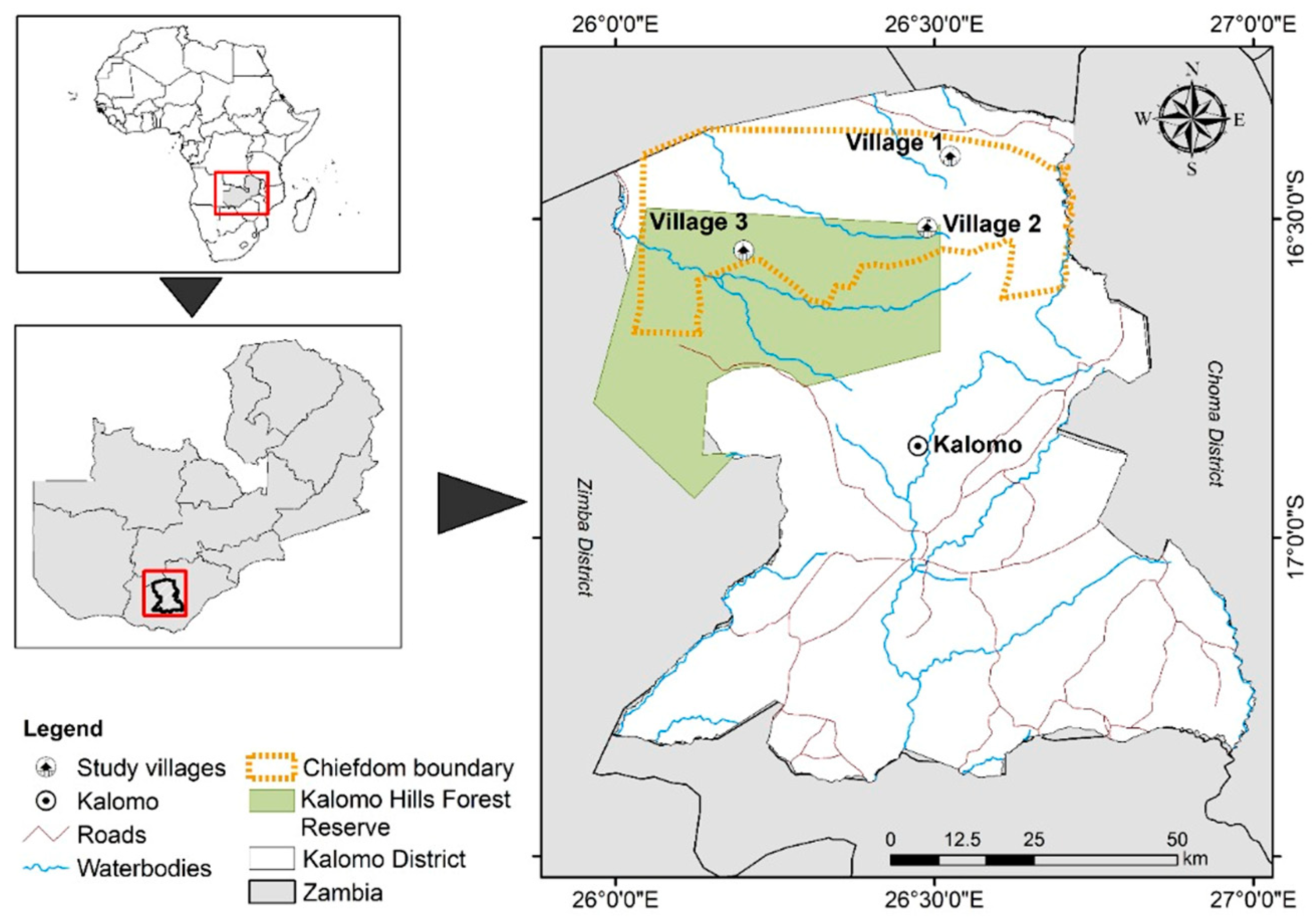
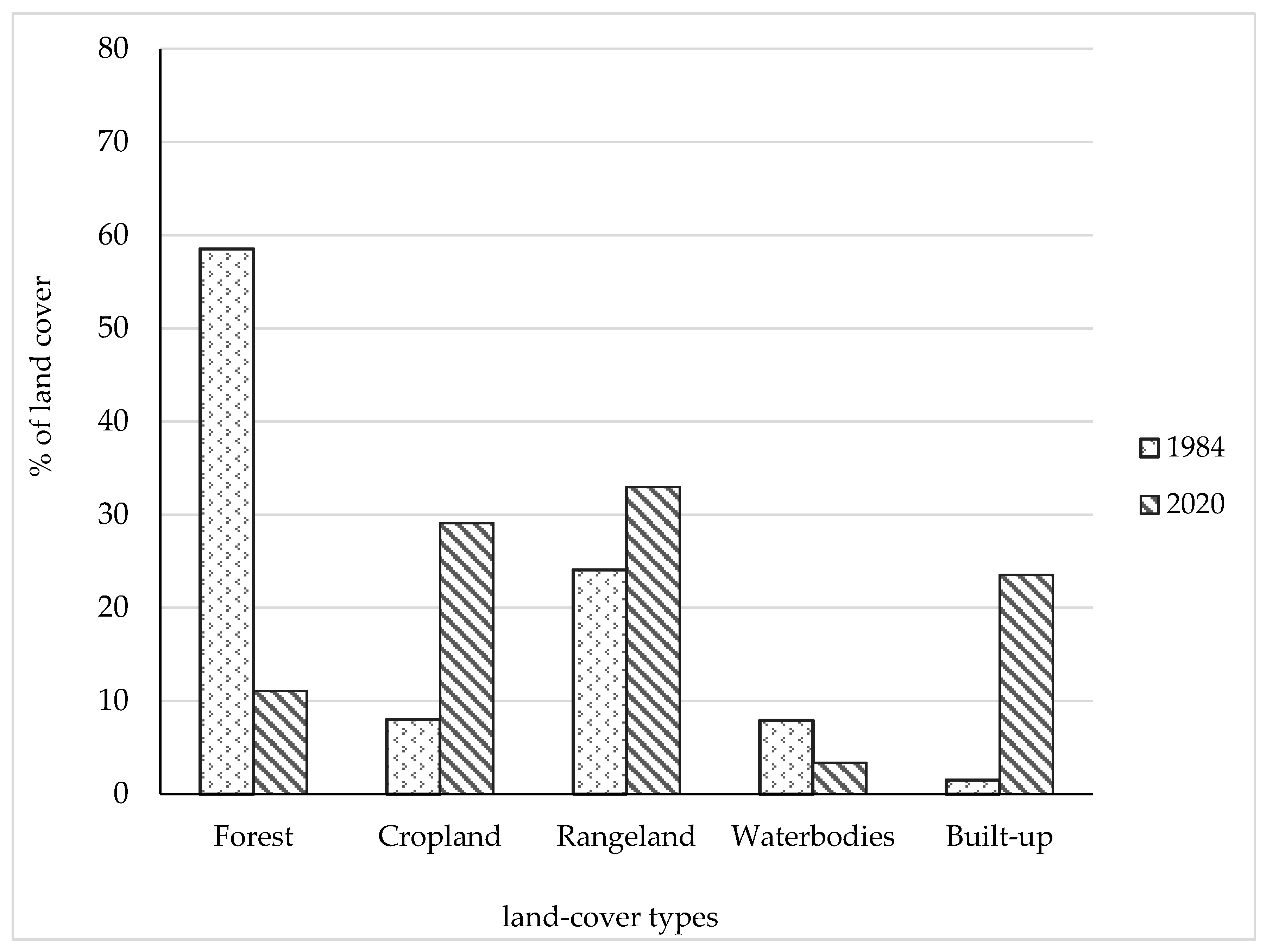
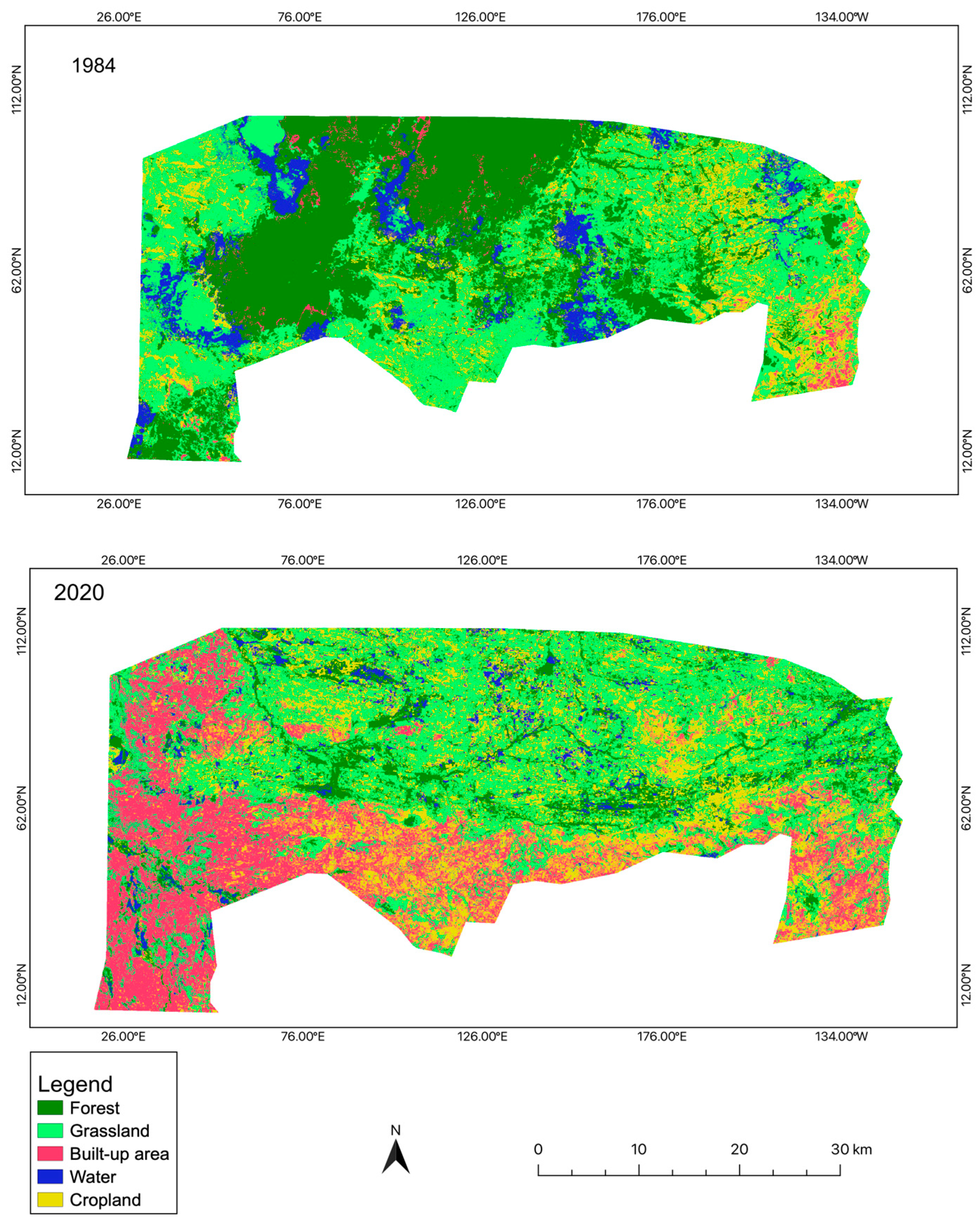
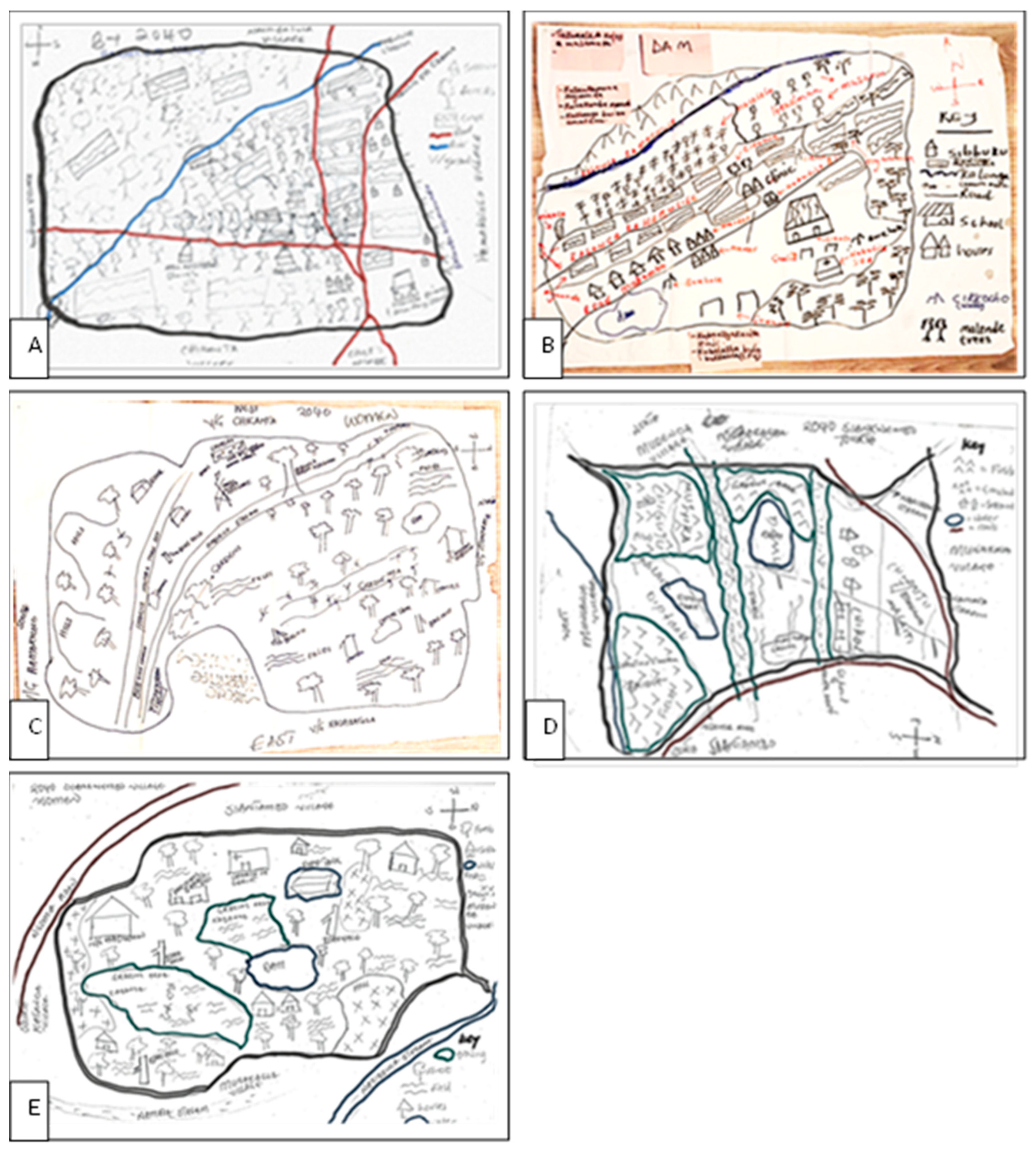
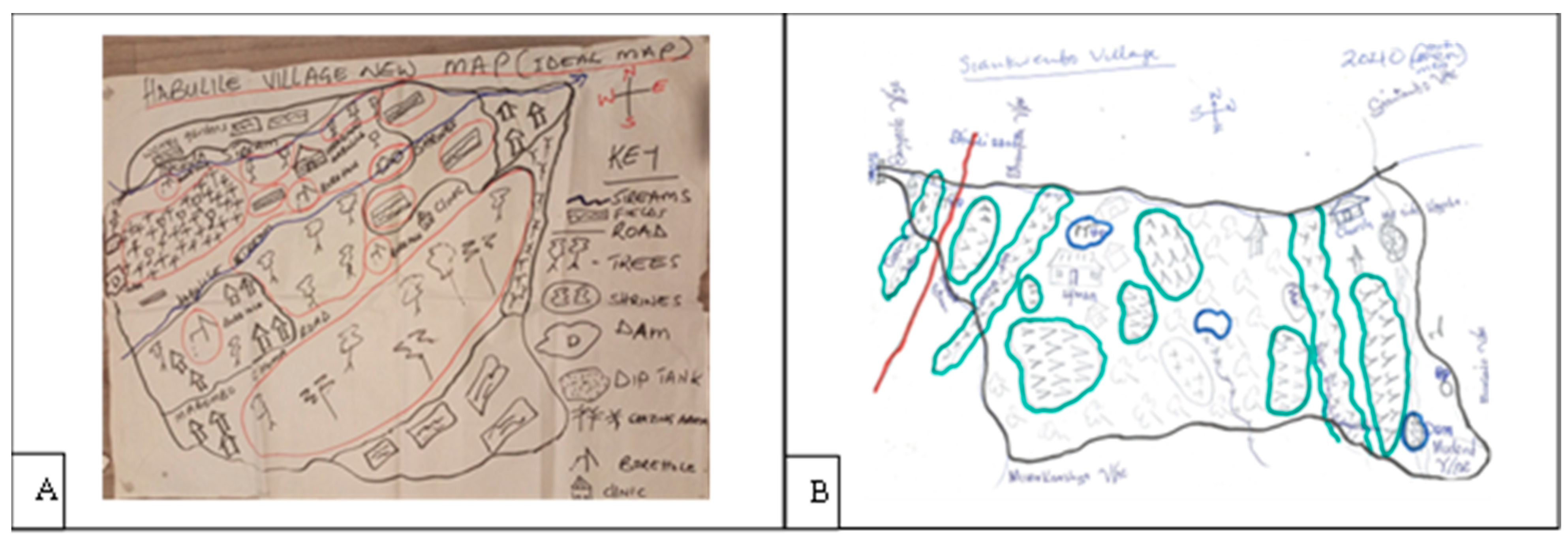
| MSP1 | MSP2 | |
|---|---|---|
| Demography (no. of respondents) | ||
| Gender | ||
| Male adults | 12 | 15 |
| Female adults | 13 | 15 |
| Youths (mixed males and females) | 10 | 15 |
| Age in years | ||
| Mean | 39.5 | 40.3 |
| Median | 32 | 37 |
| Level of education (%) | ||
| Primary | 60 | 53 |
| Secondary | 13 | 19 |
| Tertiary | 22 | 12 |
| None (no formal education) | 05 | 16 |
| Land tenure and access to land (%) | ||
| Land ownership | ||
| <2 ha | 19 | 51 |
| 2–10 ha | 70 | 45 |
| >10 ha | 11 | 4 |
| Wealth distribution (estimates of livestock) | ||
| No. of cattle (total) | 14,086 | 8985 |
| No. of goats | 22,900 | 1450 |
| Others (sheep, donkeys, pigs) | 321 | 634 |
| Land-Cover Type | Description |
|---|---|
| Forest | Areas with a spatial extent of at least 0.5 hectares, woody vegetation with a canopy cover of more than 10%, and a tree height of more than 5 m. |
| Cropland | Land actively utilised to grow agricultural crops, such as annual and perennial crops that may be irrigated or rain-fed, for commercial, peasant, and small-scale farms. |
| Rangeland | Land comprising woodland, rangeland, grasslands, plains, shrubland and pans in river basins and water channels. |
| Waterbodies | Waterlogged areas formed naturally or artificially, including perennial and non-perennial streams and rivers, swamps, lakes, and dam lakes. |
| Built-up area/bare land | Characterised by low and high-intensity infrastructures, exposed soils, surface areas (roads), wastelands and rock outcrops, and all probable bare land. |
| Stages | 1. Preparatory Phase | 2. Diagnosis of Drivers of Land Use | 3. Participatory Land-Use Mapping in Focus Groups | 4. Collective Participatory Map |
|---|---|---|---|---|
| Activities | Researchers prepare remote sensing maps. This follows study area verifications with key stakeholders a and ground-truthing of GPS coordinates. | Participants identify drivers of landscape change by interpreting land-cover maps produced in stage 1. | Sketch mapping in various focus groups (men, women, and youths). | Participatory sketching of desired future scenarios with inputs from all maps drafted in the focus groups. |
| Actors | Research team, GIS expert, and village leaders from each MSP. | MSP participants | Groups of men, women and youths involved in stage 2. | Chief’s representative, village headmen and selected village participants, CBO reps, GIS expert, and Forestry Department official. |
| Tools | Topo sheet from the Forestry Department and GPS. | Topo sheet and land-cover maps, stationery for writing. | Sketch mapping of current land cover; identify issues and causes. | Participatory maps and discussion notes. |
| Measure of degree of inclusivity | Consultations with local leaders and some villagers conversant with the area. | Moderation during the meeting to allow equitable participation, engagement and transparency in the discussions. | Mediation to have equity and participation through participatory mapping in focus groups based on gender and age. | Mediation in MSPs to ensure balanced participation. |
| Land-Cover Types | Forest | Cropland | Rangeland | Water-Bodies | Built-Up/Bare | Total for 1984 |
|---|---|---|---|---|---|---|
| Forest | 125.42 | 292.41 | 339.46 | 37.74 | 231.23 | 1026.26 |
| 12.22 | 28.49 | 33.08 | 3.68 | 22.53 | 58.51 | |
| Cropland | 6.90 | 46.04 | 42.96 | 2.08 | 42.51 | 140.48 |
| 4.91 | 0.33 | 30.58 | 1.48 | 30.26 | 8.01 | |
| Rangeland | 42.63 | 133.89 | 140.29 | 13.06 | 92.32 | 422.20 |
| 10.10 | 31.71 | 33.23 | 3.09 | 21.87 | 24.07 | |
| Waterbodies | 17.33 | 30.61 | 47.65 | 5.21 | 38.18 | 138.99 |
| 12.47 | 22.02 | 34.29 | 3.75 | 27.47 | 7.92 | |
| Built-up/bare | 1.73 | 7.35 | 8.27 | 4.71 | 8.26 | 26.09 |
| 6.64 | 28.18 | 31.72 | 18.04 | 31.66 | 1.49 | |
| Total for 2020 | 194.01 | 510.30 | 578.64 | 58.56 | 412.50 | 1754.01 |
| 11.06 | 29.09 | 32.99 | 3.34 | 23.52 | 100.0 |
| Aspects of Drivers of Land-Use Change (Direct and Proximate) | Perception Scores in MSP1 | Perception Scores in MSP2 | ||||
|---|---|---|---|---|---|---|
| Men | Women | Youths | Men | Women | Youths | |
| 1. Social and interpersonal | ||||||
| Lack of trust and legitimacy | ++ | + | ++ | + | ++ | ++ |
| Lack of accountability | +++ | +++ | ++ | +++ | ++ | +++ |
| Population increase | + | ++ | +++ | |||
| Exclusive participation | +++ | +++ | ||||
| Gender equality | +++ | + | ++ | +++ | ||
| Migration | +++ | +++ | +++ | |||
| Corruption in land administration | + | +++ | +++ | +++ | +++ | +++ |
| 2. Cultural aspects | ||||||
| Lack of respect for traditional rules and norms | +++ | ++ | + | + | ||
| Degradation of Malende (sacred forests) | ++ | |||||
| 3. Ecological/environmental | ||||||
| Increased consumption of ecological services (water) | + | + | +++ | ++ | +++ | |
| Deforestation | +++ | +++ | +++ | +++ | +++ | +++ |
| Animal diseases | +++ | ++ | +++ | +++ | ||
| Climate change (associated with persistent droughts) | +++ | +++ | +++ | +++ | ++ | +++ |
| Floods | + | ++ | ||||
| Cultivation in watersheds | ++ | ++ | ++ | ++ | ||
| Illegal logging | ++ | +++ | + | |||
| 4. Economic | ||||||
| Increase in food demand | ++ | ++ | +++ | |||
| Expanding infrastructure | +++ | +++ | ++ | +++ | + | +++ |
| Demand for charcoal (biomass energy) | ++ | + | ++ | + | ++ | |
| Agriculture | +++ | +++ | ++ | ++ | +++ | +++ |
| Overgrazing | ++ | +++ | +++ | +++ | +++ | +++ |
| Lack of off-farm employment | + | +++ | ++ | +++ | ||
| Demand for non-timber forest products | + | |||||
| 5. Governance (Organisation, Policy, and Legislation) | ||||||
| Policy inconsistencies | + | ++ | +++ | |||
| Unrealistic demands by the leader | + | |||||
| Settlements disputes | ++ | ++ | ++ | +++ | +++ | +++ |
| Poor coordination among government departments | ++ | + | +++ | |||
| Partisan politics/interference | ++ | ++ | + | |||
Disclaimer/Publisher’s Note: The statements, opinions and data contained in all publications are solely those of the individual author(s) and contributor(s) and not of MDPI and/or the editor(s). MDPI and/or the editor(s) disclaim responsibility for any injury to people or property resulting from any ideas, methods, instructions or products referred to in the content. |
© 2023 by the authors. Licensee MDPI, Basel, Switzerland. This article is an open access article distributed under the terms and conditions of the Creative Commons Attribution (CC BY) license (https://creativecommons.org/licenses/by/4.0/).
Share and Cite
Siangulube, F.S.; Ros-Tonen, M.A.F.; Reed, J.; Bayala, E.R.C.; Sunderland, T. Spatial Tools for Inclusive Landscape Governance: Negotiating Land Use, Land-Cover Change, and Future Landscape Scenarios in Two Multistakeholder Platforms in Zambia. Land 2023, 12, 804. https://doi.org/10.3390/land12040804
Siangulube FS, Ros-Tonen MAF, Reed J, Bayala ERC, Sunderland T. Spatial Tools for Inclusive Landscape Governance: Negotiating Land Use, Land-Cover Change, and Future Landscape Scenarios in Two Multistakeholder Platforms in Zambia. Land. 2023; 12(4):804. https://doi.org/10.3390/land12040804
Chicago/Turabian StyleSiangulube, Freddie Sayi, Mirjam A. F. Ros-Tonen, James Reed, Eric Rega Christophe Bayala, and Terry Sunderland. 2023. "Spatial Tools for Inclusive Landscape Governance: Negotiating Land Use, Land-Cover Change, and Future Landscape Scenarios in Two Multistakeholder Platforms in Zambia" Land 12, no. 4: 804. https://doi.org/10.3390/land12040804
APA StyleSiangulube, F. S., Ros-Tonen, M. A. F., Reed, J., Bayala, E. R. C., & Sunderland, T. (2023). Spatial Tools for Inclusive Landscape Governance: Negotiating Land Use, Land-Cover Change, and Future Landscape Scenarios in Two Multistakeholder Platforms in Zambia. Land, 12(4), 804. https://doi.org/10.3390/land12040804






